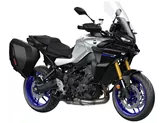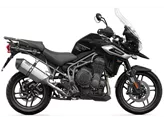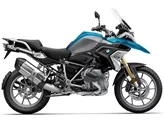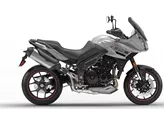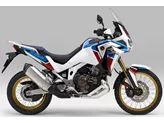Triumph Tiger 900 GT Pro 2020 vs. BMW R 1250 GS 2021
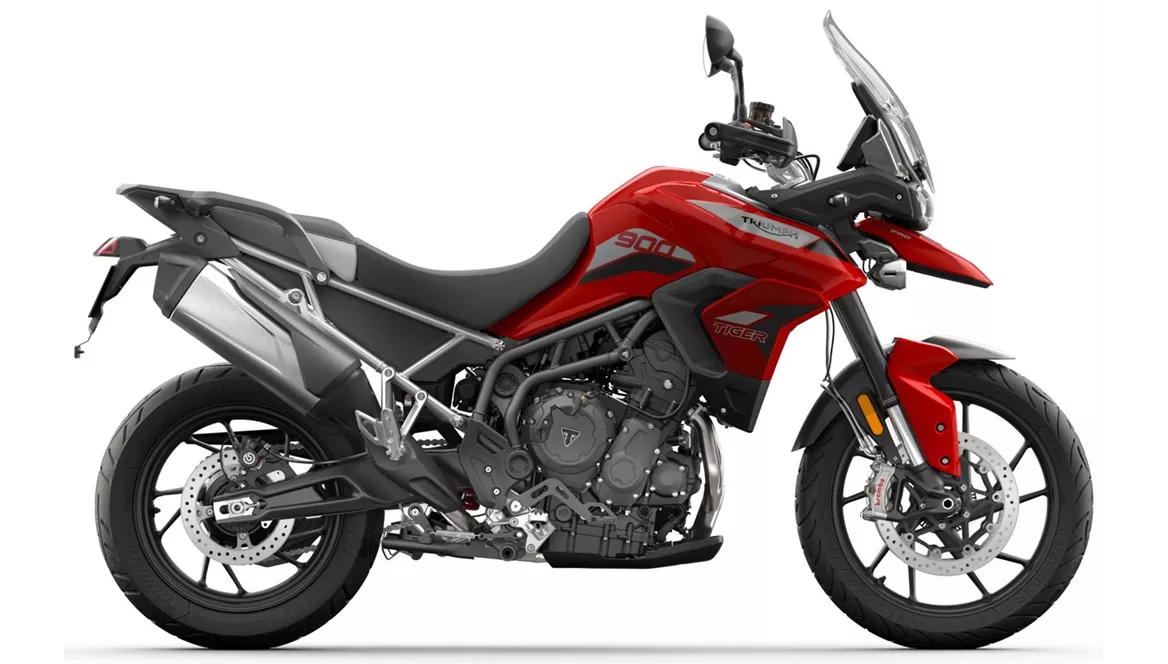
Triumph Tiger 900 GT Pro 2020

BMW R 1250 GS 2021
Overview - Triumph Tiger 900 GT Pro 2020 vs BMW R 1250 GS 2021
In terms of engine and drive train, the Triumph Tiger 900 GT Pro 2020 features an in-line three-cylinder engine with a displacement of 888cc. It produces 95.2 horsepower and 87 Nm of torque. The engine is started electrically and power is transmitted through a chain transmission. On the other hand, the BMW R 1250 GS 2021 is equipped with a boxer twin-cylinder engine with a displacement of 1254cc. It delivers a more powerful 136 horsepower and 143 Nm of torque. The engine is also started electrically but power is transmitted through a prop shaft.
In terms of suspension, the Triumph Tiger 900 GT Pro 2020 is equipped with an upside-down telescopic fork with a diameter of 45mm at the front and a swing arm suspension with a monoshock at the rear. The front suspension offers a travel of 180mm and can be adjusted for compression and rebound. The rear suspension provides a travel of 170mm and can be adjusted for preload and rebound. On the other hand, the BMW R 1250 GS 2021 features a telelever front suspension with a diameter of 37mm and a single swing arm suspension with a monoshock at the rear. The front suspension offers a travel of 190mm and can be adjusted for preload. The rear suspension provides a travel of 200mm and can be adjusted for preload and rebound.
In terms of chassis, both motorcycles have a steel frame. The Triumph Tiger 900 GT Pro 2020 has a tubular frame type with a rake of 65.4 degrees and a trail of 133.3mm. The BMW R 1250 GS 2021 has a load-bearing engine frame type with a slightly smaller rake of 62.9 degrees and a trail of 109mm.

Triumph Tiger 900 GT Pro 2020
In terms of brakes, both motorcycles are equipped with double disk brakes at the front. The Triumph Tiger 900 GT Pro 2020 does not specify the type of brakes, while the BMW R 1250 GS 2021 features ABS and anti-slipping control.
In terms of dimensions and weights, both motorcycles have a front tire diameter of 19 inches and a rear tire diameter of 17 inches. The Triumph Tiger 900 GT Pro 2020 has a rear tire width of 150mm, while the BMW R 1250 GS 2021 has a rear tire width of 170mm. The wheelbase of the Triumph Tiger 900 GT Pro 2020 is 1556mm, while the BMW R 1250 GS 2021 has a slightly shorter wheelbase of 1525mm. The seat height of the Triumph Tiger 900 GT Pro 2020 is adjustable from 810mm to 830mm, while the BMW R 1250 GS 2021 has a higher seat height that is adjustable from 850mm to 870mm. Both motorcycles have a fuel tank capacity of 20 liters.

BMW R 1250 GS 2021
In terms of equipment, the Triumph Tiger 900 GT Pro 2020 is equipped with LED daytime running lights, LED headlights, a heated seat, and a TFT display. The BMW R 1250 GS 2021 features cornering lights, LED headlights, and an adjustable windscreen.
In terms of strengths, the Triumph Tiger 900 GT Pro 2020 stands out for its three-cylinder engine, agile turn-in behavior, quickshifter as standard, electronically adjustable suspension strut, generous standard equipment, good ergonomics, good wind and weather protection, and long-distance capability. On the other hand, the BMW R 1250 GS 2021 excels in ride comfort, ergonomics, a powerful engine, great connectivity app, easy-to-read display, confident feel in the saddle, practical riding aids, versatile chassis that accommodates every route, and ease of riding.
In terms of weaknesses, the Triumph Tiger 900 GT Pro 2020 has a flood of switches on the left handlebar, while the BMW R 1250 GS 2021 has a rough overall appearance and gearshifts at low revs can be somewhat clumsy.
Technical Specifications Triumph Tiger 900 GT Pro 2020 compared to BMW R 1250 GS 2021
Pros and Cons in comparison
Pros and Cons in comparison
Triumph Tiger 900 GT Pro 2020

Good things take time, they say. Triumph has kept to this and with the Tiger 900 GT Pro has put a motorbike on the cast rims that continues the long, successful path of the 800 with many detail improvements and is just as much a practical everyday motorbike as it is for extended tours and trips. The Triple has become sharper and yet is still a harmonious unit with which even beginners can do no wrong without boring the experienced motorcyclist. And that's thanks to sufficient suspension travel on roads of the most varied qualities as well as quite moderate off-road passages. There was little to complain about in our first impression, but we will certainly take a closer look at the Tiger.
BMW R 1250 GS 2021

The GS also impressed us with its versatility during the test in November 2021. We rode the bike on a wide variety of terrain and were once again very satisfied. The motorbike convinces in every situation with its easy handling and practicality. On the other hand, it can also be ridden delightfully irrationally.
Price Comparison Avarage Market Price Triumph Tiger 900 GT Pro vs BMW R 1250 GS
There are a few key differences between a Triumph Tiger 900 GT Pro 2020 and a BMW R 1250 GS 2021. In terms of price, the actual average price of a BMW R 1250 GS 2021 is about 58% higher. Compared to BMW R 1250 GS 2021 there are less Triumph Tiger 900 GT Pro 2020 bikes available on the 1000PS.de Marketplace, specifically 5 compared to 66. It takes less time to sell a BMW R 1250 GS with 55 days compared to 88 days for the Triumph Tiger 900 GT Pro. Since model year 2020 1000PS.de editors have written 10 reviews for the Triumph Tiger 900 GT Pro and 50 reviews for the BMW R 1250 GS since model year 2019. The first review for the Triumph Tiger 900 GT Pro was published on 12/3/2019 and now has more than 65,300 views. This compares to more than 305,600 views for the first review on BMW R 1250 GS published on 9/19/2018.







